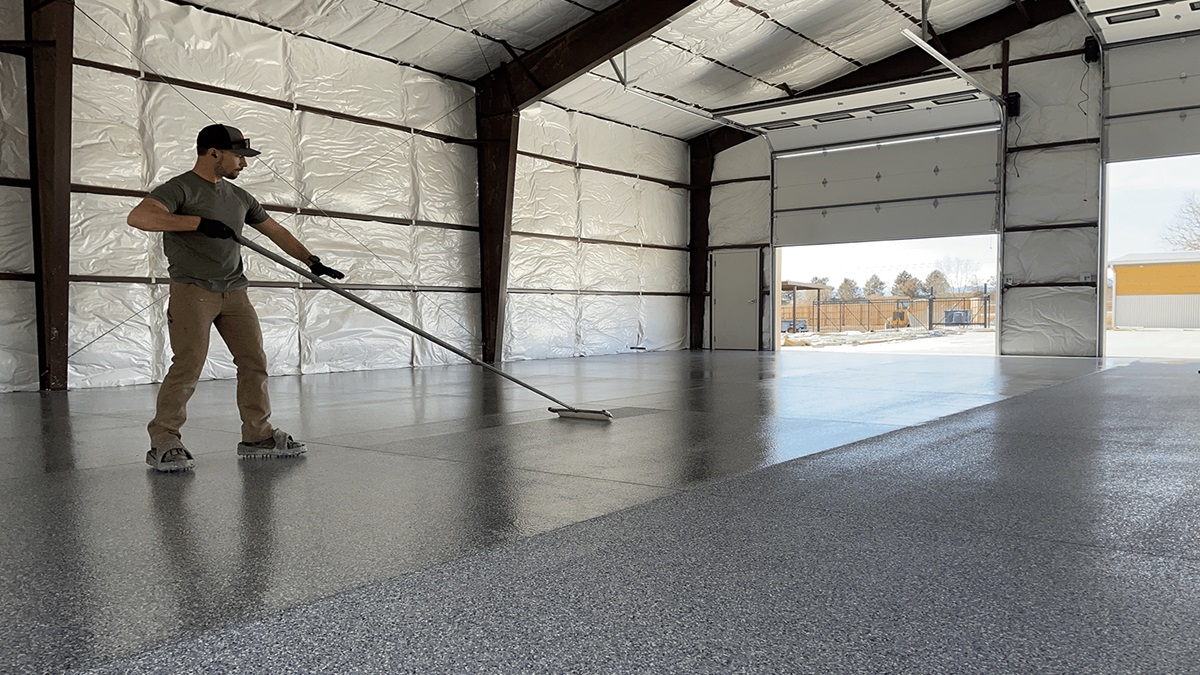
Why Choose Polyaspartic Floor Coating Over Epoxy?
A Fresh Look At Floor Coating Choices
Polyaspartic floor coating has many advantages over epoxy. This is especially true if you want a quick, strong, and good-looking finish. It cures much faster, often in less than an hour, compared to epoxy, which takes about 24 hours. This means you can use your space again sooner. Polyaspartic is also more challenging. It resists impacts, scratches, and chemicals better than epoxy. This makes it perfect for busy areas. It can handle extreme temperatures without becoming brittle, unlike epoxy. Additionally, polyaspartic stays the same color even in sunlight, while epoxy can turn yellow. It also offers decorative options like chip blends and custom colors, making floors look nicer. Also, polyaspartic smells less during application. This is because it has fewer Volatile Organic Compounds (VOCs).
What Makes Polyaspartic Special?
Polyaspartic floor coating is a type of polyurea, and it’s gaining popularity for many reasons. Here are some standout features:
Quick Drying Time
Unlike epoxy, which can take days to cure, polyaspartic coatings dry incredibly fast. This means you can get back to using your space much sooner. Imagine applying a floor coating in the morning and walking on it in the evening!
Durability and Flexibility
Polyaspartic coatings are highly durable and resistant to abrasions, impacts, and chemicals. They are also more flexible than epoxy, which makes them less likely to crack.
UV Resistance
One major downside of epoxy is that it can turn yellow and fade when exposed to UV light. Polyaspartic coatings, on the other hand, are UV resistant, making them perfect for spaces with lots of sunlight.
Application Temperature Range
Polyaspartic can be applied at a wider range of temperatures than epoxy, making it a more versatile option for various environments.
Easy Maintenance
Maintaining a polyaspartic-coated floor is simple. Regular cleaning with a floor polish or waxing applicator keeps the floor pristine.
The Case For Epoxy: A Brief Comparison
While poly aspartic has many advantages, epoxy isn’t without its strengths. Here’s a quick look at how epoxy stacks up:
Cost
Epoxy is generally less expensive than polyaspartic, which might sway your decision if you’re on a tight budget.
Familiarity
Epoxy has been around for a long time and is a well-known option in the market. Many people and equipment manufacturers are more familiar with its use and performance.
Thickness
Epoxy coatings can be applied in thicker layers, benefiting floors that withstand heavy loads and high traffic.
Breaking Down The Benefits: A Handy Table
Let’s list the key differences between polyaspartic and epoxy floor coatings in a table. This will allow for a more precise comparison. LINK Excel.Sheet.12 “Book1”
“Sheet1!R1C1:R9C3” a f 5 h * MERGEFORMAT
|
Feature |
Polyaspartic |
Epoxy |
|
Drying Time |
1-2 hours |
24-72 hours |
|
Durability |
High |
Moderate to High |
|
UV Resistance |
Yes |
No |
|
Application Temperature |
Wide range (up to -30°F) |
Limited range (above 50°F) |
|
Maintenance |
Easy, compatible with floor polish applicator |
Moderate, requires regular maintenance |
|
Cost |
Higher |
Lower |
|
Flexibility |
High |
Low |
|
Thickness |
Moderate |
High |
<!– [if supportFields]><![endif]–>
Real-Life Scenarios: Polyaspartic In Action
Residential Use
Polyaspartic coatings are perfect for home garages. Their quick drying time means less downtime for your vehicles. Plus, the coating’s UV resistance ensures it looks fresh even in direct sunlight.
Commercial Spaces
Polyaspartic coatings shine in commercial settings, where appearance and durability are crucial. They are used in showrooms and restaurants. The coatings have a sleek finish and can handle heavy foot traffic and frequent cleaning with floor finish applicators.
Industrial Settings
Polyaspartic’s chemical resistance and durability are key in industrial areas. These coatings withstand harsh conditions, making them ideal for warehouses and factories.
Tips for Choosing Your Floor Coating
Selecting the right floor coating involves considering your specific needs and circumstances. Here are some tips to help you decide:
Assess Your Space
Consider the amount of sunlight, temperature variations, and wear and tear your floor will experience. Polyaspartic is a strong contender for areas with high UV exposure and temperature fluctuations.
Budget Considerations
While polyaspartic coatings offer many benefits, they come at a higher cost. Evaluate your budget. Compare the initial cost to long-term benefits. These include less maintenance and a longer life.
Application and Maintenance
Think about the ease of application and future maintenance. Polyaspartic dries quickly. It works with floor polish applicators, making it convenient for busy places.
Stories From The Floor: Customer Experiences
A Garage Transformation
Tom from Maine shared how his garage floor was transformed with poly aspartic coating. “I was amazed at how quickly it dried. By the next day, I was parking my car on it. It’s been over a year, and it still looks brand new, even with the Maine winters.”
Restaurant Makeover
Jenny, a restaurant owner in California, opted for polyaspartic in her dining area. “The floor looks fantastic and stands up to spills and heavy foot traffic. Cleaning is a breeze with my floor waxing applicators.”
Industrial Strength
Mike, who manages a warehouse, switched to polyaspartic coating after his epoxy floor showed signs of wear. “Polyaspartic has been a game-changer. It handles our forklifts and heavy pallets without a scratch.”
Making The Right Choice For You
Choosing between polyaspartic and epoxy coatings depends on your specific needs and circumstances. Epoxy is cost-effective and familiar. But polyaspartic stands out. It has quick drying, UV resistance, and durability. Are you a homeowner looking to upgrade your garage? Or a business owner wanting a sleek and durable floor? Or managing an industrial space needing a rugged solution? If so, polyaspartic floor coating could be your best choice.
Final Thoughts: Your Floor’s Future
Ultimately, the choice between polyaspartic and epoxy comes down to what’s most important for your space. Consider these factors. Don’t hesitate to ask professionals for advice. They can tailor it to your situation. Remember, investing in a high-quality floor coating today can save you time, money, and headaches in the future.


